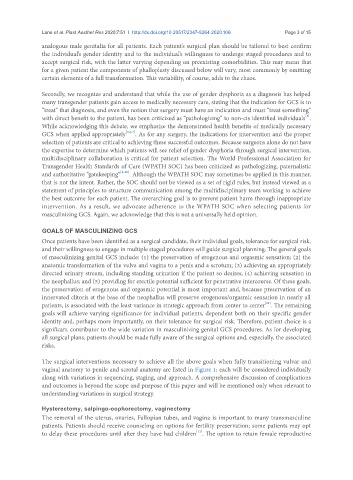Page 587 - Read Online
P. 587
Lane et al. Plast Aesthet Res 2020;7:51 I http://dx.doi.org/10.20517/2347-9264.2020.106 Page 3 of 15
analogous male genitalia for all patients. Each patient’s surgical plan should be tailored to best confirm
the individual’s gender identity and to the individual’s willingness to undergo staged procedures and to
accept surgical risk, with the latter varying depending on preexisting comorbidities. This may mean that
for a given patient the components of phalloplasty discussed below will vary, most commonly by omitting
certain elements of a full transformation. This variability, of course, adds to the chaos.
Secondly, we recognize and understand that while the use of gender dysphoria as a diagnosis has helped
many transgender patients gain access to medically necessary care, stating that the indication for GCS is to
“treat” that diagnosis, and even the notion that surgery must have an indication and must “treat something”
[5]
with direct benefit to the patient, has been criticized as “pathologizing” to non-cis identified individuals .
While acknowledging this debate, we emphasize the demonstrated health benefits of medically necessary
GCS when applied appropriately [4,6,7] . As for any surgery, the indications for intervention and the proper
selection of patients are critical to achieving these successful outcomes. Because surgeons alone do not have
the expertise to determine which patients will see relief of gender dysphoria through surgical intervention,
multidisciplinary collaboration is critical for patient selection. The World Professional Association for
Transgender Health Standards of Care (WPATH SOC) has been criticized as pathologizing, paternalistic
and authoritative “gatekeeping” [8-10] . Although the WPATH SOC may sometimes be applied in this manner,
that is not the intent. Rather, the SOC should not be viewed as a set of rigid rules, but instead viewed as a
statement of principles to structure communication among the multidisciplinary team working to achieve
the best outcome for each patient. The overarching goal is to prevent patient harm through inappropriate
intervention. As a result, we advocate adherence to the WPATH SOC when selecting patients for
masculinizing GCS. Again, we acknowledge that this is not a universally held opinion.
GOALS OF MASCULINIZING GCS
Once patients have been identified as a surgical candidate, their individual goals, tolerance for surgical risk,
and their willingness to engage in multiple staged procedures will guide surgical planning. The general goals
of masculinizing genital GCS include: (1) the preservation of erogenous and orgasmic sensation; (2) the
anatomic transformation of the vulva and vagina to a penis and a scrotum; (3) achieving an appropriately
directed urinary stream, including standing urination if the patient so desires; (4) achieving sensation in
the neophallus; and (5) providing for erectile potential sufficient for penetrative intercourse. Of these goals,
the preservation of erogenous and orgasmic potential is most important and, because preservation of an
innervated clitoris at the base of the neophallus will preserve erogenous/orgasmic sensation in nearly all
[11]
patients, is associated with the least variance in strategic approach from center to center . The remaining
goals will achieve varying significance for individual patients, dependent both on their specific gender
identity and, perhaps more importantly, on their tolerance for surgical risk. Therefore, patient choice is a
significant contributor to the wide variation in masculinizing genital GCS procedures. As for developing
all surgical plans, patients should be made fully aware of the surgical options and, especially, the associated
risks.
The surgical interventions necessary to achieve all the above goals when fully transitioning vulvar and
vaginal anatomy to penile and scrotal anatomy are listed in Figure 1; each will be considered individually
along with variations in sequencing, staging, and approach. A comprehensive discussion of complications
and outcomes is beyond the scope and purpose of this paper and will be mentioned only when relevant to
understanding variations in surgical strategy.
Hysterectomy, salpingo-oophorectomy, vaginectomy
The removal of the uterus, ovaries, Fallopian tubes, and vagina is important to many transmasculine
patients. Patients should receive counseling on options for fertility preservation; some patients may opt
to delay these procedures until after they have had children . The option to retain female reproductive
[12]

